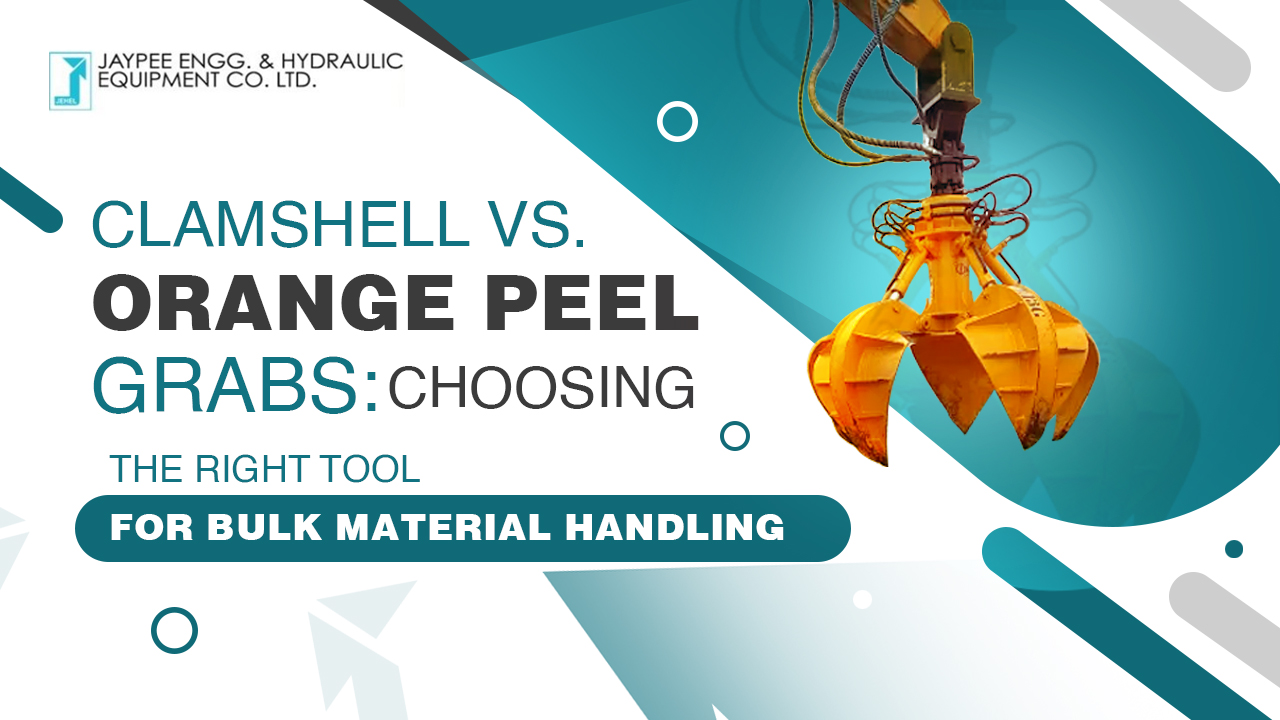It is undeniably true that achieving the intended degree of operational efficiency for an organization in the constantly changing industrial landscape depends on the choice of equipment. In bulk material handling, orange peel and clamshell grabs are the most popular methods. But which one meets your needs then?
This is about more than just “prefer and use.” It’s about important performance metrics like profit, safety, and productivity. By 2025, it is anticipated that over 4 million warehouse robots will be deployed in 50,000+ warehouses, highlighting the importance of equipment selection in contemporary material handling operations.
Clamshell Grabs
A clamshell grab bucket is a huge mouth with two hinges that can open and close. The design is simple, yet elegant, which makes the grab perfect for loose materials. The two-bucket arrangement secures a positive grip that prevents spillage during transport, which is essential for optimal operational efficiency.
They are best suited for handling items such as sand, gravel, soil, grain, and even coal. Their smooth closing action eliminates the chances of material loss. The design is such that full closure will be achieved, forming an airtight space around the material during lifting.
Clamshell grabs are available in multiple shapes and sizes. They can be adapted for precision work as well as light and heavy materials, for their precise work and large-scale industrial operations.
The Power of Orange Peel Grabs
Unlike the Orange Peel Grabs, these grabs have 4 to 8 gripping tines, which will remain open instead of fully closing together. Thus, they can be used for large and irregularly shaped loads, which include, but are not limited to, steel scraps and big iron wastes.
Due to the curved tines, unusual shapes of materials can be deftly managed in contrast to grabs. In other words, orange peel grabs can deal with any challenges in loads.
Working with levelled piles of materials, orange peel grabs have an advantage over others. The multiple tines can dig deeper and get to greater depths, unlike other grabs, which gives them an edge over others used for the same work.
Important Differences and Why They Matter
The difference between a clamshell grab and an orange peel grab lies more in their construction and operation. A clamshell grab uses two buckets on hinges that are opened and closed to pick and release pieces of construction. It is good for bulk materials like sand, gravel, and soil.
The basic difference between the two grabs lies in their method of holding different kinds of materials. Clamshell grabs fully surround the materials that they have. Orange peel grabs use several contact points to grab hold of the load. They are different in efficiency for other materials.
In handling fine, dry materials, clamshell grabs are more effective. Their complete closure prevents the spillage of small particles. Orange peel grabs better handle irregular shapes and sizes, as they prove more adaptable.
The shapes and sizes of the load also affect the different kinds of grabs. The operating mechanism differs in both as well. Clamshell grabs usually need to be set up with two rope systems or have their operation opened and closed hydraulically. Orange peel grabs require more sophisticated control systems because they must synchronize the simultaneous opening and closure of multiple jaws.
Choosing Based on Material Type
Items of consistent size or powdered and granular ingredients are ideal for a grab clamshell bucket. There is minimal material loss during transportation, and the closure is finished. Mining for fine materials, uniform rubbish management, and agriculture are the industries that gain the most.
Unlike scrap yards, which deal with irregular bulk materials, demolition sites use clamshell grabs for scrap metals, irregular rocks, and other mixed materials. These are best handled with orange peel grabs, and a good grab buckets manufacturer will suggest them for these works.
It is also important to consider the material’s flow behavior. The ideal materials for clamshell grabs are those that flow freely. Orange peel tines must penetrate materials that bridge or have a tendency to adhere to one another.
Operational Points to Remember
Clamshell grabs need less skill and experience from the operator and are more forgiving and simple to utilize. Due to their ease of use and minimal staff training requirements, they are most appropriate for establishments with a high operator turnover rate. The simple open-close action provides fewer chances of errors.
Orange peel grabs require more skill, as operator precision is needed for coordinating multiple jaws. These are still very useful as, with a bit of experience, operators can use them with great accuracy and speed.
Regular maintenance varies between different equipment. Clamshell grabs require maintenance less frequently because they have fewer moving parts. While orange peel grabs require more attention because of their more complex design, they offer more flexibility in their use.
Making the Correct Decision
Start with the kinds of materials you use most frequently. Clamshell grab buckets work well when working with loose, generally homogeneous materials. Due to their adaptability and versatility, orange peel grabs work best for mixed materials or irregular shapes.
Consider your operational environment. For indoor tasks where parts are more predictable, clamshell grabs are more efficient. For outdoor work that involves varied debris or scrap materials, the flexibility of orange peels is more useful.
Keeping the budget in mind, both the initial and the ongoing costs are factors. While clamshell grabs may have lower initial costs and maintenance, orange peel grabs seem to shine in more difficult tasks and could offer a better ROI.
Also, think of needs that may arise in the future. If further changes aimed at an expansion could potentially occur, the adaptability of orange peels could offer strategic flexibility that would be valuable in a growth initiative.
Conclusion
Both Clamshell and orange peel grabs are proven tools for material handling. Understanding your materials, your operational requirements, and your goals will provide a clear path to the optimal decision.
Success in bulk material handling comes from the appropriate selection of tools and tasks. Doing so will result in enhanced productivity, lowered operational costs, and improved safety at the workplace. Whether you prefer the dependable effectiveness of a clamshell bucket or the powerful versatility of an orange peel grab, proper selection will improve these metrics.
Choosing the right grab buckets manufacturer to partner with for material handling upgrades makes all the difference. JEHEL has modern manufacturing hydraulic plants with the proper equipment and technology for advanced production and precision engineering. Having top brand clamshell and orange peel grab design engineering makes sure that the clients receive world-class hydraulic grabs tailored to their requirements with full support.
Want to learn how JEHEL can greatly improve bulk material handling operations? Get in touch with our team to find the right tools for the right problems.


